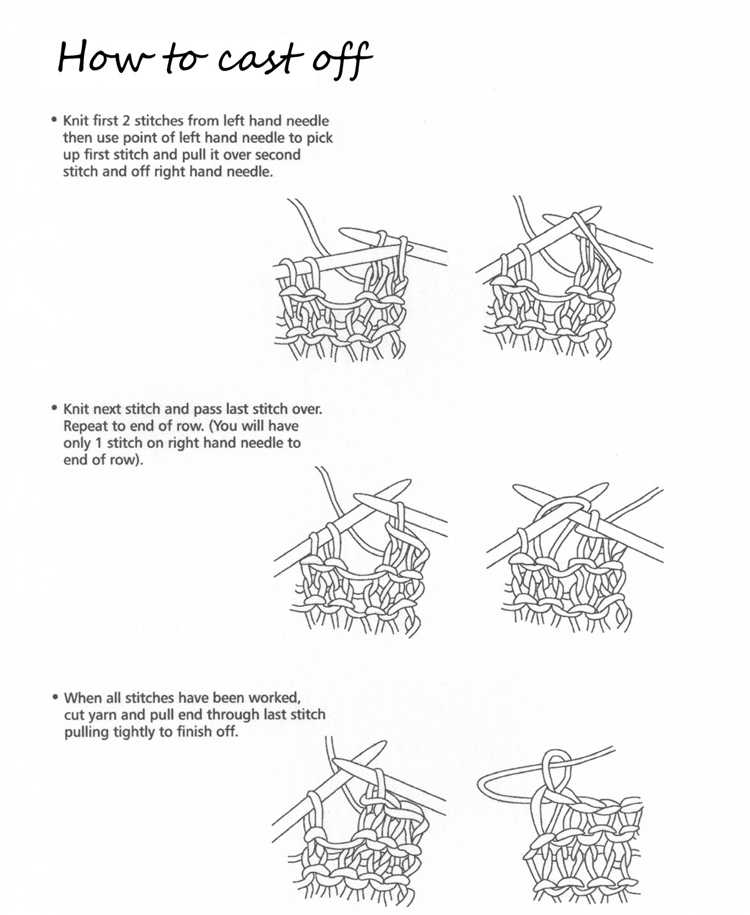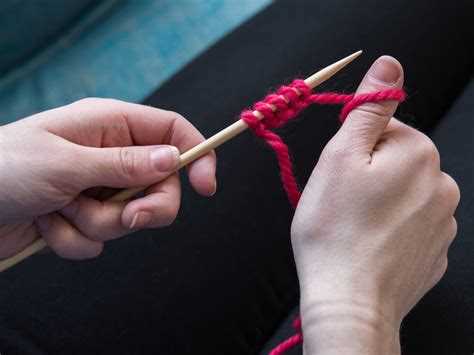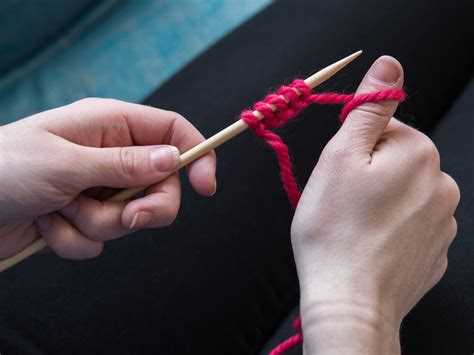Knitting is a popular hobby that allows you to create beautiful garments and accessories using yarn and needles. One of the first steps in starting a knitting project is casting on stitches onto the needles. Casting on is the foundation of any knitting project, and it determines the number of stitches you will have on your needles to work with.
In this step-by-step tutorial, you will learn how to cast on 1 stitch in knitting. This technique is useful when you need to add stitches to your project or when starting small items like i-cords or embellishments. Although casting on just one stitch may sound simple, it can be a little tricky for beginners. However, with practice and patience, you’ll be able to master this technique.
To cast on 1 stitch, you will use the single cast on method. This method is a basic cast on technique and is often used at the beginning of a project. The single cast on method involves making a loop with your working yarn and slipping it onto the knitting needle. It’s a simple technique that creates a sturdy and secure foundation for your stitches.
By following this step-by-step tutorial, you will learn the essential skills needed to cast on 1 stitch in knitting. Whether you’re a beginner or an experienced knitter looking to refresh your skills, mastering this technique will open up a world of possibilities in your knitting projects. So grab your yarn and needles, and let’s get started!
Why Knowing How to Cast On 1 Stitch in Knitting is Important
Learning how to cast on 1 stitch in knitting may seem like a simple technique, but it is actually a fundamental skill that is important to master. By knowing how to cast on 1 stitch, you gain the ability to begin your knitting projects with precision and control.
Here are a few reasons why knowing how to cast on 1 stitch in knitting is important:
- Starting a new project: When you begin a knitting project, you typically need to cast on the required number of stitches to form the foundation of your work. Being able to cast on 1 stitch allows you to add stitches one at a time, ensuring accuracy and control over the number of stitches you have.
- Adding stitches: There may be times in a knitting project when you need to add stitches to your work. Whether it’s to create a buttonhole, shape a neckline, or add an intricate pattern, knowing how to cast on 1 stitch gives you the flexibility to increase your stitch count as needed.
- Fixing mistakes: Knitting is not always perfect, and mistakes can happen. If you drop a stitch or realize you’re missing a stitch in your work, being able to cast on 1 stitch allows you to easily add the missing stitch and continue knitting without having to unravel your entire project.
- Creating decorative edges: Casting on 1 stitch can also be used to create decorative edges in your knitting projects. By adding a few extra stitches at the beginning or end of a row, you can create a neat and finished edge that adds a professional touch to your work.
Overall, knowing how to cast on 1 stitch in knitting is an essential skill that provides you with the foundation to start your projects, make adjustments as needed, and add decorative touches to your work. With practice, this technique will become second nature, allowing you to tackle a wide range of knitting projects with confidence.
Step-by-Step Tutorial: Casting On 1 Stitch in Knitting
When starting a knitting project, one of the most basic techniques you’ll need to know is how to cast on stitches. Casting on creates the foundation row of stitches on your knitting needle. In this tutorial, we will guide you through the process of casting on 1 stitch in knitting.
- Create a Slipknot: Start by making a slipknot. To do this, make a loop with the working yarn, bring the end of the yarn through the loop, and tighten the knot by pulling both ends of the yarn.
- Hold the Needle: Hold the knitting needle with the slipknot in your dominant hand.
- Insert the Needle: Insert the tip of the needle into the slipknot from front to back, bringing the needle behind the working yarn.
- Wrap the Working Yarn: Take the working yarn with your non-dominant hand, and bring it under and over the needle, creating a loop around the needle.
- Pull Through the Loop: Using the needle, pull the loop of yarn through the slipknot, creating a new stitch on the needle.
- Adjust the Tension: Gently pull the working yarn to adjust the tension of the newly formed stitch. Make sure it is snug but not too tight.
- Repeat: Repeat steps 2-6 to cast on additional stitches as needed for your project.
With this step-by-step tutorial, you can now confidently cast on 1 stitch in knitting. Remember to practice the technique and adjust the tension until you feel comfortable with the process. Happy knitting!
Materials and Tools You’ll Need
Before you start learning how to cast on 1 stitch in knitting, you’ll need a few basic materials and tools. These are essential for any knitting project, including casting on.
Here’s a list of what you’ll need:
- Yarn: Choose a yarn that is appropriate for your project. Different yarns have different weights and fibers, so pick one that suits your needs.
- Knitting Needles: You’ll need a pair of knitting needles in an appropriate size for your yarn. The size of the needles will determine the tension and size of your stitches.
- Scissors: You’ll need a pair of scissors to cut the yarn once you’ve finished your cast on.
- Tapestry Needle: This needle is used for weaving in loose ends of yarn once your project is complete.
- Measuring Tape: To ensure accuracy and consistency in your knitting, a measuring tape is essential for checking gauge and measuring your progress.
These are the basic materials and tools you’ll need to get started with casting on 1 stitch in knitting. As you become more experienced, you may find that there are additional tools that you’ll want to add to your collection.
Step 1: Make a Slip Knot
Before you can begin casting on stitches in knitting, you’ll first need to make a slip knot. A slip knot is a loop that will serve as the first stitch on your knitting needle.
To make a slip knot, follow these steps:
- Hold the end of the yarn in your right hand and the tail end in your left hand.
- With your right hand, create a loop with the yarn by crossing the end over the tail.
- Take the end of the yarn and pass it through the loop from the back to the front.
- Gently pull both ends of the yarn to tighten the knot.
The slip knot should be snug on the needle but still be able to slide easily. It’s important to create the slip knot loosely enough so that it can be easily worked through in the subsequent steps.
Once you have successfully made a slip knot, you can move on to the next step in casting on stitches in knitting.
Step 2: Insert the Needle Through the Slip Knot
Once you have created a slip knot, hold the working yarn in your right hand and the needle with the slip knot in your left hand. Insert the needle from front to back through the slip knot, keeping both the yarn and the needle in your left hand.
Make sure the needle goes under the yarn as it passes through the slip knot. This will create a loop around the needle.
Make sure the loop around the needle is not too tight or too loose, but instead snug enough to hold the slip knot in place.
Now that you have inserted the needle through the slip knot and created a loop around the needle, you are ready to move on to the next step of casting on stitches in knitting.
Step 3: Wrap the Yarn Around the Needle
Once you have the slipknot on your needle, you’re ready to start wrapping the yarn to create your first stitch.
Hold the working yarn in your right hand, making sure there is enough slack to easily wrap it around the needle.
- Bring the yarn over the top of the needle towards the back of your work.
- Next, bring the yarn under the needle and towards the front, creating a loop around the needle.
- Hold the loop with your left thumb and index finger to keep it in place.
At this point, you have successfully wrapped the yarn around the needle, creating one stitch. Make sure the loop is not too tight or too loose, but just snug enough to easily slide along the needle.
Now you are ready to move on to the next step, which is to pull the loop through the slipknot to create your second stitch.
Step 4: Pull the Yarn Through the Stitch
Once you have inserted the needle into the stitch on your left-hand needle, it’s time to pull the yarn through the stitch. This step is crucial in creating a new stitch on your right-hand needle.
- Using your right hand, grasp the yarn tail that is coming from the skein of yarn. Ensure that you have a good grip on the yarn so that it doesn’t slip out of your hand during the next step.
- With your right hand, pull the yarn tail through the stitch you just inserted the needle into. To do this, you can either use your fingers to grab onto the yarn and pull it through, or you can use the tip of the needle to hook the yarn and pull it through.
- As you pull the yarn through, you will notice that a loop is formed on your right-hand needle. This loop represents the new stitch that you have just cast on.
- Make sure that the new stitch is not too tight or too loose. It should be snug but still able to slide easily along the needle. Adjust the tension of the stitch by gently pulling on the yarn tail and the working yarn. Experiment with different amounts of tension until you find one that works for you.
- Repeat steps 1-4 until you have cast on the desired number of stitches.
Now that you’ve successfully pulled the yarn through the stitch, you’re ready to move on to the next step in knitting. This technique of casting on one stitch at a time is useful for when you need to add stitches to your knitting project at specific points, such as when shaping a garment or adding decorative elements.
Step 5: Tighten the Stitch
Once you’ve cast on your stitch, it’s important to tighten it to ensure that it is secure and won’t unravel. Here’s how to tighten the stitch:
- Hold onto the working yarn: With your left hand, hold onto the working yarn that is coming from the ball of yarn. This will prevent the stitch from slipping or becoming loose.
- Pull the working yarn: Use your right hand to pull the working yarn gently but firmly, creating a taut stitch. Be careful not to pull too tightly, as this can distort the stitch.
- Check the tension: After tightening the stitch, check the tension by gently pulling on the stitch with your fingers. It should feel secure and not easily come undone.
- Continue knitting: Once the stitch is tightened, you can continue knitting according to your pattern instructions.
Remember to tighten each stitch as you cast it on to ensure a consistent tension throughout your project. Practice tightening the stitch until you feel comfortable with the process.
FAQ:
What is casting on in knitting?
Casting on in knitting is the process of creating the first stitch on the knitting needle. It is the very first step in starting a new knitting project.
Why do I need to cast on 1 stitch?
Casting on 1 stitch is usually done when you need to add an extra stitch to your knitting project. This can be for various reasons, such as creating a buttonhole or adding a decorative element to your knitting.
What tools do I need to cast on 1 stitch in knitting?
To cast on 1 stitch in knitting, you will need a pair of knitting needles and your chosen yarn. You may also require a crochet hook or a tapestry needle, depending on the method you choose to use.
Can you explain the step-by-step process of casting on 1 stitch in knitting?
Sure! To cast on 1 stitch in knitting, you can use a variety of methods, such as the backward loop cast-on or the cable cast-on. It is best to follow a visual tutorial or written instructions with accompanying images to ensure you perform the technique correctly.
What are some tips for casting on 1 stitch in knitting?
When casting on 1 stitch in knitting, it is important to keep your tension loose to prevent the stitch from becoming too tight. Additionally, make sure to choose a method that suits your project and desired outcome. Practice the technique on scrap yarn before attempting it on your actual project.


